Hi Everyone,
FACTS:
- I am deeply invested in the food of the Caribbean having a place of prominence on the world stage.
- I have no problems with my images being used for educational and non-profit purposes as along as the source is credited.
- I draw the line at the use of my work for commercial purposes, and for profit, without prior permission AND a written agreement of use and rights.
 In order to use and access my work, my main request is that permission is sought first. Why this escapes so many people is baffling. It’s as if people feel that they are in someway entitled to your work. They take it, claim it and own it.
In order to use and access my work, my main request is that permission is sought first. Why this escapes so many people is baffling. It’s as if people feel that they are in someway entitled to your work. They take it, claim it and own it.
Now, I ask you to imagine with me:
▪ my frustration when I travel around Georgetown and see my images as part of the signage of many eating establishments and in one case a well-known supermarket.
▪ my frustration travelling around Trinidad and seeing my images on food establishments there too.
▪ my frustration moving around Barbados and seeing my images as part of the food signage of food establishments.
▪ my frustration and outrage at one of my images being used to brand, market, advertise and sell a product available widely in Trinidad.
In each case above, I was never contacted before the use of my work. On more than one occasion I have had the perpetrators and strangers say to me, “But it is only a photograph, what is the big deal?” Well today I would like to address that question and in order to do so, I have chosen a few of my food photographs to highlight and explain the process behind the scenes long before I pick up my camera. These images didn’t just happen; they called for money, thought, time, effort and a certain degree of skill.
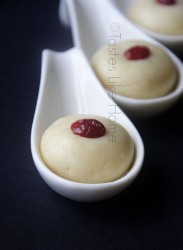
Cynthia Nelson)
Peera
It took me 12 hours and 55 minutes spread over a period of 2 days to test and make the Peera. I tested 2 batches and then got the desired results on the 3rd try. And if I didn’t get it right on the third try, I would have continued until I got it right. That is the kind of dedication that goes into anything I do. Of course it goes without saying that a new set of ingredients was needed each time the recipe was tested. Careful thought went into how best to plate/present the Peera, all of this, long before the camera is picked up.
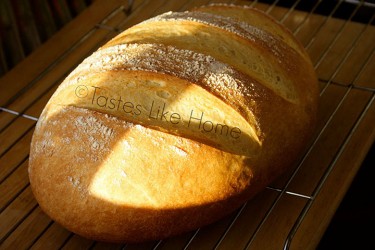
Bread
There are quick breads, and then there are those spreads that benefit from a long period of fermentation for the flavour to develop. When I decided to make this bread, I wanted the lighting to be reminiscent of Saturday afternoon baking, and light streaming through the kitchen window. What this meant is that I had to plan the timing of this bread from the kneading of the dough, to proofing, to extracting it from the oven just in time to capture the kind of lighting I wanted to communicate my message.
I had to take into consideration the time of the year and where the sun is located at a certain time and the angle at which it comes through the window. I wanted the sun to shine on the bread and to create a shadow; therefore, in positioning the bread, I moved it around several ways before I got the desired effect.
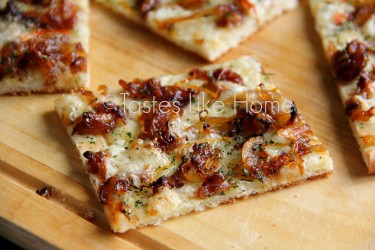
(Photo by Cynthia Nelson)
Flatbread with Caramelized Onions
In order to feature the recipe of flatbread with caramelized onions, I first had to make the caramelized onions and then let it cool completely before using. Caramelizing onions is something that takes time, you can’t simply slice onions toss them in the pan and leave them to cook. You have to moderate the heat, and keep the onions moving while it cooks gently. It is about coaxing the natural sugar of the onions to a stage where it comes to the fore and start caramelizing. The caramelization results in layers of flavour that cannot be rushed. Caramelizing onions takes at least 1 hour.
Next came the kneading and resting of dough for the flatbread followed by the combining of the two ingredients (caramelized onions and dough) to go into the oven. Choosing to photograph and showcase the flatbread cut into pieces was deliberate. It was to offer enticement of a manageable portion.
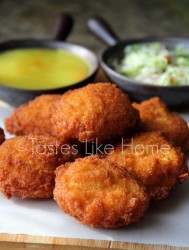
(Photo by Cynthia Nelson)
Brazilian Acarajé
Last year I wrote telling you about sitting for 4 straight hours removing the skin of black eye peas to make a Brazilian street food favourite – acarajé (a fritter of African influence). With water-shriveled fingers I set about making acarajé. The entire process took up three-quarters of a day, but I did it because it was important to the story I wanted to tell about the food of our neighbours.
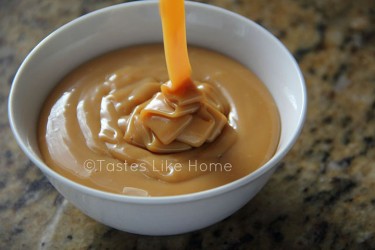
(Photo by Cynthia Nelson)
Dulce de leche
A few weeks ago, I shared with you the making of dulce de leche, a well-known milk dessert. Cooking the dulce de leche on the stovetop takes anywhere from 3 – 5 hours depending on the consistency you are after. Like the caramelized onions, it is not simply a matter of setting it to cook and walking way, you have to monitor the cooking so that the water does not dip below a certain level. Once done, it takes a few hours for the can to cool before it can be opened.
As you can see, in each case, long before I picked up my camera there are hours of work and preparation that go into crafting the subject for presentation. It is not just a photograph and it is a big deal. Is it really too much to ask permission to use someone’s work? Especially when you are seeking to profit from it? Many of you are probably shaking your heads and saying, “Oh, poor, naïve Cynthia.”
I still hold out the hope that people will do the right thing.
Cynthia




